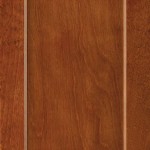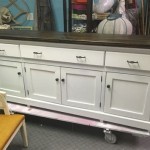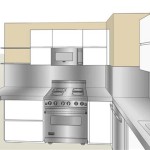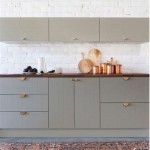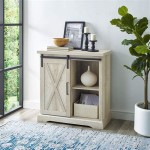Optimal Handle Position On Kitchen Cabinets: A Comprehensive Guide
The placement of handles on kitchen cabinets is a crucial element in both the aesthetics and functionality of a kitchen design. It is a detail that, when properly executed, enhances the user experience and contributes to the overall visual appeal of the space. Conversely, poorly placed handles can lead to daily frustrations, impacting both the ergonomics and the perceived quality of the kitchen.
Selecting the appropriate handle position necessitates a careful consideration of several factors, including cabinet style, size, and the desired design aesthetic. There is no single "correct" answer, as the ideal placement often depends on individual preferences and the specific characteristics of the kitchen cabinetry. However, understanding the underlying principles and common practices can significantly aid in making informed decisions.
This article provides a comprehensive guide to determining the optimal handle position on kitchen cabinets. It explores various placement options, considering both functional and aesthetic aspects. Furthermore, it addresses common challenges and offers practical advice for achieving a cohesive and user-friendly kitchen design.
Understanding the Importance of Handle Placement
The placement of cabinet handles is not merely a decorative afterthought; it directly impacts the usability and ergonomics of the kitchen. Incorrectly positioned handles can lead to awkward reaching, strained wrists, and a general sense of discomfort. Over time, these seemingly minor inconveniences can contribute to fatigue and decreased satisfaction with the kitchen space.
From a design perspective, handle placement plays a pivotal role in defining the style and character of the kitchen. The alignment, spacing, and orientation of handles can subtly influence the overall visual balance and harmony of the room. Consistent and well-thought-out handle placement creates a sense of order and sophistication, while haphazard placement can detract from the overall aesthetic appeal.
Furthermore, the type of handle selected can also influence its optimal placement. Different handle styles, such as knobs, pulls, and recessed handles, have varying ergonomic characteristics and aesthetic implications. Understanding these differences is essential for making informed decisions about both the type of handle and its placement on the cabinet.
Key Considerations for Optimal Handle Placement
Several factors must be taken into account when determining the ideal handle position on kitchen cabinets. These considerations encompass both functional and aesthetic aspects, and they should be carefully weighed to achieve a balanced and harmonious design.
Cabinet Type and Size: The size and type of cabinet significantly influence the optimal handle placement. For standard base cabinets, handles are typically positioned horizontally, while on wall cabinets, they are often placed vertically. Larger cabinets may require longer pulls or two handles to facilitate easier opening and closing. Drawers, being wider than doors, usually feature centrally placed handles, although wider drawers may benefit from two handles for improved stability and ease of use.
Door Style and Construction: The style of the cabinet door, whether it is a shaker, slab, or raised-panel design, can also impact handle placement. On shaker-style doors, handles are commonly placed on the stile, the vertical frame member. Slab doors offer more flexibility, allowing for placement closer to the top or bottom edge. Raised-panel doors often feature handles positioned on the raised panel itself or on the surrounding frame. The construction and thickness of the cabinet door should also be considered to ensure that the handle is securely mounted and does not damage the cabinet.
Ergonomics and Accessibility: The primary function of a cabinet handle is to provide a comfortable and accessible grip for opening and closing the cabinet. The handle should be positioned at a height and location that minimizes strain and awkward reaching. For base cabinets, handles are typically placed within easy reach, usually between 2 and 4 inches from the top edge. For wall cabinets, the handles are often positioned closer to the bottom edge, ensuring that they are easily accessible for users of different heights. Consider individuals with mobility limitations or disabilities when determining handle placement, ensuring that the kitchen is accessible and inclusive for all users.
Aesthetic Considerations: The handle placement should complement the overall aesthetic style of the kitchen. Consistent and symmetrical handle placement contributes to a sense of order and visual harmony. Consider aligning handles with other design elements, such as the edges of drawers or the hardware on appliances. The finish and style of the handles should also harmonize with the cabinets and the overall color scheme of the kitchen. Pay attention to the spacing between handles and adjacent cabinets or appliances, ensuring that there is adequate clearance for comfortable use.
Common Handle Placement Options and Guidelines
While personal preference plays a role in handle placement, there are established guidelines and common practices that can serve as a starting point. These guidelines help to ensure both functionality and aesthetic appeal.
Base Cabinets: For base cabinets, horizontal placement is the most common approach. Handles are typically positioned 2 to 4 inches from the top corner of the door, either left or right depending on the cabinet's hinge location. This placement provides a comfortable reach and aligns with the natural motion of opening a lower cabinet. For wider base cabinets, consider using two handles spaced evenly apart to provide better balance and support.
Wall Cabinets: Wall cabinets typically feature vertically placed handles. These handles are generally positioned 2 to 4 inches from the bottom corner of the door. This placement makes the handle easily accessible from below. Similar to base cabinets, wider wall cabinets may benefit from two handles. Alternatively, a longer vertical pull can be used.
Drawers: Handles on drawers are commonly centered horizontally on the drawer front. For smaller drawers, a single knob or pull is usually sufficient. For wider drawers, consider using two handles, spaced evenly apart, approximately one-third of the drawer width from each side. This configuration provides better balance and prevents the drawer from tilting when opened.
Appliance Handles: When integrating appliances into the kitchen cabinetry, consider aligning the handles on the cabinets with those on the appliances. This creates a cohesive and unified look. This detail can significantly impact the overall design aesthetic.
Specialty Cabinets: Specialty cabinets, such as pantry cabinets or corner cabinets, may require customized handle placement. Consider the specific function and design of the cabinet when determining the optimal handle position. For example, a tall pantry cabinet may benefit from a longer vertical pull or two handles placed at different heights.
Addressing Specific Challenges
Even with careful planning, certain challenges may arise when determining handle placement on kitchen cabinets. These challenges often involve specific cabinet configurations, architectural constraints, or aesthetic considerations.
Frameless Cabinets: Frameless cabinets, also known as European-style cabinets, have a minimalist design with no face frame. This can present challenges when determining handle placement, as there is no stile or rail to serve as a visual guide. In these cases, careful measurements and mock-ups are essential to ensure consistent and accurate handle placement. Consider using a template or jig to aid in drilling the holes for the handles.
Inset Cabinets: Inset cabinets, where the door sits flush with the face frame, require precise handle placement to avoid interference. The handles must be positioned so that they do not rub against the frame or prevent the door from closing properly. Accurate measurements and testing are crucial to ensure a smooth and functional operation.
Uneven Cabinet Heights: In kitchens with varying cabinet heights, maintaining visual consistency can be challenging. Consider aligning the handles on the upper cabinets with those on the lower cabinets to create a sense of order. Alternatively, adjust the handle placement slightly to compensate for the height differences, ensuring that the handles are still easily accessible.
Corner Cabinets: Corner cabinets, whether they are blind corner cabinets or lazy Susan cabinets, present unique challenges for handle placement. Consider the swing direction of the door and the location of adjacent cabinets when determining the optimal handle position. Ensure that the handle does not interfere with the operation of the corner mechanism or obstruct access to other cabinets.
Accessibility Concerns: For individuals with mobility limitations or disabilities, special considerations must be taken into account when determining handle placement. Ensure that the handles are easily reachable and require minimal force to operate. Consider using D-shaped pulls or lever handles, which are easier to grip and require less hand strength. Comply with accessibility guidelines, such as those outlined in the Americans with Disabilities Act (ADA), to ensure that the kitchen is inclusive and accessible for all users.
Tools and Techniques for Precise Handle Installation
Accurate handle installation is essential for achieving a professional and polished look. Using the right tools and techniques can help to ensure that the handles are securely mounted and properly aligned. A variety of tools and techniques are available to aid in this process.
Cabinet Hardware Jig: A cabinet hardware jig is a specialized tool designed to facilitate accurate and consistent handle placement. These jigs typically consist of a template with adjustable guides that allow you to precisely position the holes for the handle screws. Using a jig can significantly reduce the risk of errors and ensure that the handles are aligned properly.
Drill Bit Selection: Choosing the correct drill bit size is crucial for a secure and stable handle installation. The drill bit should be slightly smaller than the diameter of the handle screws. This will allow the screws to grip the wood properly and prevent them from stripping or loosening over time. Consult the handle manufacturer's instructions for the recommended drill bit size.
Level and Measuring Tape: A level and measuring tape are essential for ensuring that the handles are straight and evenly spaced. Use these tools to accurately mark the locations for the handle holes. Double-check your measurements to avoid mistakes.
Screwdriver and Drill: A screwdriver or drill can be used to install the handle screws. If using a drill, set it to a low speed to avoid over-tightening the screws and damaging the cabinet. It is essential to use the correct type of screwdriver head that matches the screws being used. Avoid over-tightening or stripping the screw head.
Pilot Holes: Drilling pilot holes before installing the handle screws can help to prevent the wood from splitting or cracking. Use a small drill bit to create a pilot hole at each marked location. This will make it easier to insert the screws and ensure a more secure and stable connection.
Test the Alignment: Before fully tightening the handle screws, test the alignment to ensure that the handle is positioned correctly and that the cabinet door or drawer opens and closes smoothly. Make any necessary adjustments before tightening the screws completely.

Cabinet Hardware Placement Guide

The Ultimate Guide For Cabinet Hardware Placement And Sizing

How To Place Cabinet Knobs Pulls
Cabinet Hardware Placement Where To Put Knobs And Handles Vevano

A Designer S Guide To Hardware Placement

How To Install Cabinet Door And Drawer Handles Knobs Pulls

The Ultimate Guide For Cabinet Hardware Placement And Sizing

Kitchen Cabinet Handle Placement Dos And Don Ts Living Letter Home
Cabinet Hardware Placement Where To Put Knobs And Handles Vevano

Shaker Cabinet Handle Installation With The Hardware Jig True Position Tools
Related Posts


